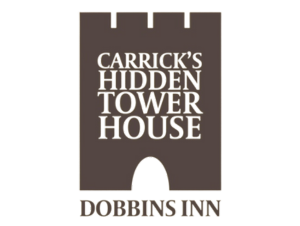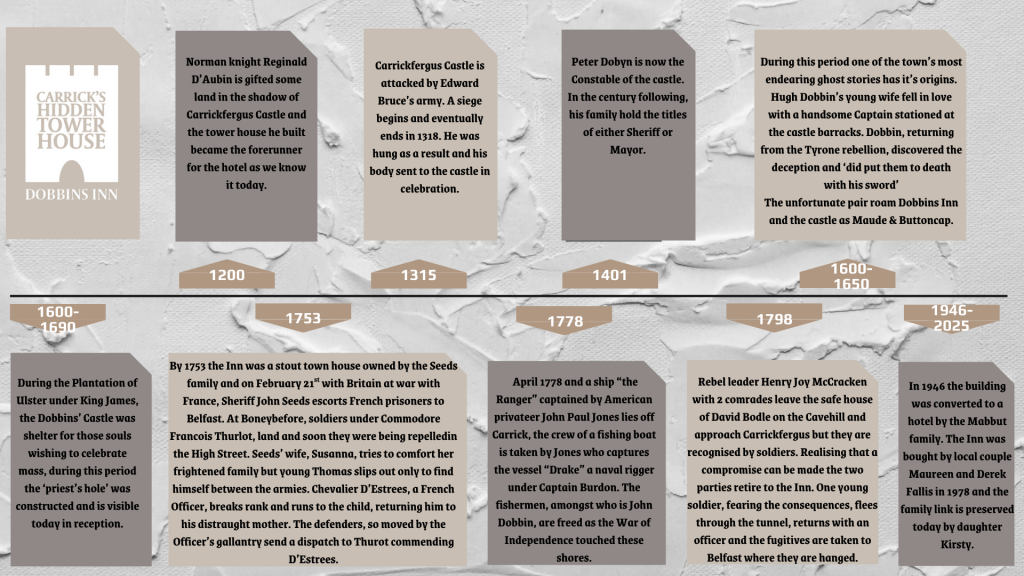Over 500 years of stories, stones and spirits
The Living History of Dobbins Inn
Foundations in the Norman Age
The origins of Dobbins Inn can be traced back to the early 1200s, in the shadow of the mighty Carrickfergus Castle, completed by Sir Hugh de Lacy. One of his knights, Reginald D’Aubin, was granted a parcel of land nearby. On it, he built a tower house—its stones still forming the core of the building that stands today. This humble beginning marked the start of a story that has spanned centuries, wars, and families.
Siege, Survival, and the Rise of a Family
By 1315, Carrickfergus had become a target of Edward Bruce’s campaign in Ireland. While the town fell quickly, the castle stood firm, defended by a small group under John Logan. Among them was Thomas Dobyn, an early ancestor of the Dobbin family, whose courage became the stuff of legend. When Bruce was eventually defeated and executed in 1318, part of his remains were sent back to Carrickfergus and gruesomely displayed at the castle—a chilling reminder of the conflict.
In 1401, Peter Dobyn held the prestigious post of castle constable. His salary—drawn from the profits of the town’s mill, a sum granted for defense, and free grazing rights—reflects both his standing and the importance of the role. Over the next century, members of the Dobbin family served repeatedly as Sheriff or Mayor, establishing a civic legacy that would last generations.
Faith, Secrets, and Spectres
During the Plantation of Ulster in the early 1600s, Dobbins Inn became a discreet sanctuary for Catholics wishing to celebrate mass. A hidden “priest’s hole” was created for protection—this concealed space still exists near the reception, a quiet relic of religious resistance.
This period also gave rise to one of the town’s most enduring ghost stories. Legend tells of Hugh Dobbin, who returned from rebellion to discover his young wife entangled in an affair with a soldier stationed nearby. In a fit of rage, he killed them both. Their spirits, known as Maude and Buttoncap, are said to roam the Inn and castle to this day, trapped in a moment of betrayal and sorrow.
The Inn Through Centuries of Change
In 1662, a curious note in Miskimmin’s History and Antiquities of Ireland records Mayor James Dobbin as “keeping an Inn and selling ales”—evidence that the building may well be Ulster’s oldest surviving inn. By then, Dobbins was already entrenched in local life.
The Inn and its family witnessed tumultuous times. In 1642, young Dobbin children played by the shoreline as General Monroe’s army prepared to march on Newry. Nearly fifty years later, in 1690, Eliza Dobbin—now grown—stood with her cousin Robert Clarke, watching the arrival of William of Orange’s forces, poised for their historic march to the River Boyne.
By the early 1700s, the Dobbin family began to disperse. Some sought new fortunes in London, others in Armagh and even across the Atlantic. In 1753, the Seeds family had taken ownership. During that time, amid the threat of French invasion, young Thomas Seeds was rescued by the gallant Chevalier D’Estrees. The French officer’s act of humanity during a skirmish touched the hearts of locals, who wrote to the French command in praise. Books once owned by young Thomas were later discovered during Inn renovations and are now proudly displayed.
Storms from Distant Shores
In 1778, the American privateer John Paul Jones sailed into local waters, capturing the British ship Drake. Among those affected by the episode was fisherman John Dobbin—his release marking the War of Independence’s brief, but vivid, touch upon Carrickfergus.
Two decades later, the Inn again played a role in political upheaval. Rebel leader Henry Joy McCracken sought refuge here during the 1798 rebellion. But betrayal came quickly. A young soldier, fearing for his safety, fled through the Inn’s tunnel and returned with authorities. McCracken and his comrades were taken to Belfast and executed. The rising had come to a tragic end, and once again, Dobbins Inn stood at the intersection of history.
A Building Reborn
Throughout the 19th century, the building was split into two private townhouses. It remained this way until 1946, when the Mabbutt family transformed it into a hotel. Over the years, it hosted celebrities including film star Jack Hawkins and carpet tycoon Cyril Lord. The Inn quickly gained a reputation for warm hospitality and lively conversation, a tradition that would continue well into the next century.
The Fallis Family Legacy
In 1978, Dobbins Inn entered a new chapter under the care of Maureen and Derek Fallis. For more than four decades, they nurtured and developed the hotel while preserving its unique atmosphere. In 2018, their extraordinary contribution to the hospitality industry was recognised with a Lifetime Achievement Award from the Carrickfergus Business Awards.
Their daughter, Kirsty, now leads the business into a new era—combining modern comforts with historic charm and ensuring the legacy of Dobbins Inn continues to thrive.
Restoration and Rediscovery
A major heritage restoration project was undertaken in 2019 in collaboration with Carrickfergus Town Heritage Initiative, Mid and East Antrim Borough Council, and the Heritage Lottery Fund. This extensive work included the restoration of the building’s dual character: one half returning to its 14th-century castle roots, the other to its 15th-century townhouse elegance.
Traditional windows and roofing were installed, open fireplaces brought back to life, and hidden architectural features—including wooden beams and stonework from the 15th century—were uncovered. These discoveries captured the imagination of locals and historians alike.
Dendrochronology revealed that parts of the building date as far back as 1530, confirming its use as a residence for the Dobbin family. In later years, it served as the town’s bakery and even as a Royal Irish Constabulary Barracks, during which time a new frontage disguised the tower house beneath.
A New Era for a Timeless Inn
Today, Dobbins Inn stands as both a cherished local institution and a living historical monument. Under Kirsty Fallis’s stewardship, it continues to blend tradition with innovation, offering guests a warm welcome in surroundings steeped in character. With every restored beam and uncovered stone, the Inn tells a story—one of survival, spirit, and hospitality—that continues to unfold for generations to come.

